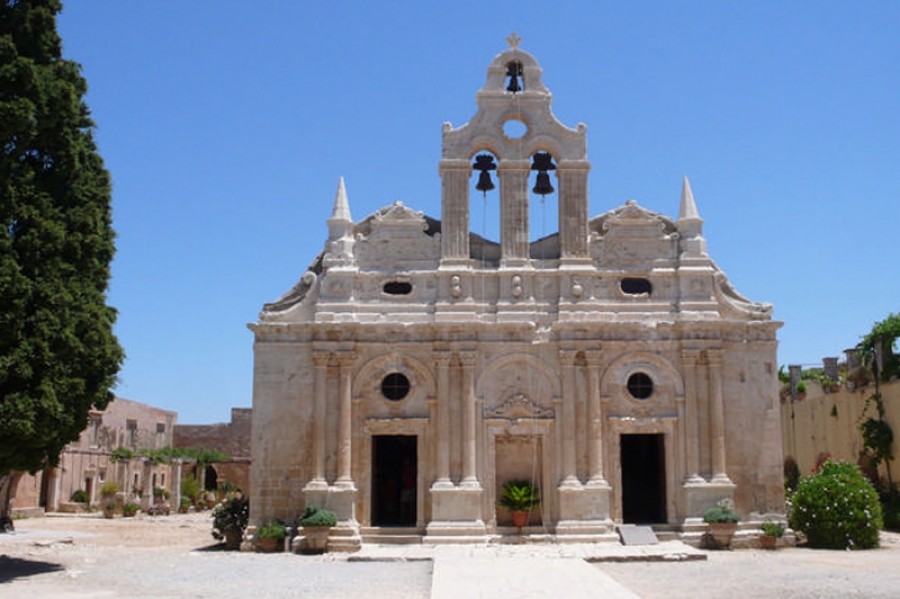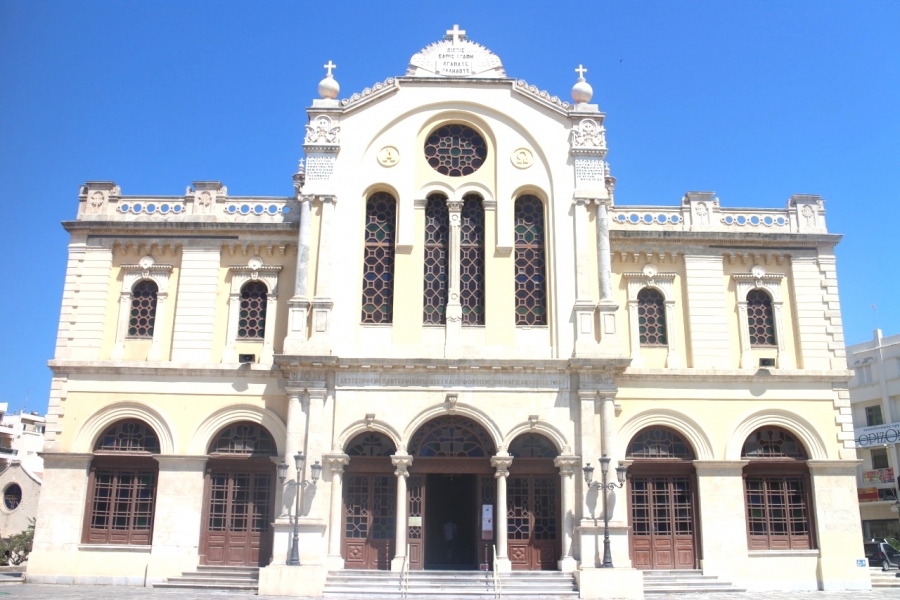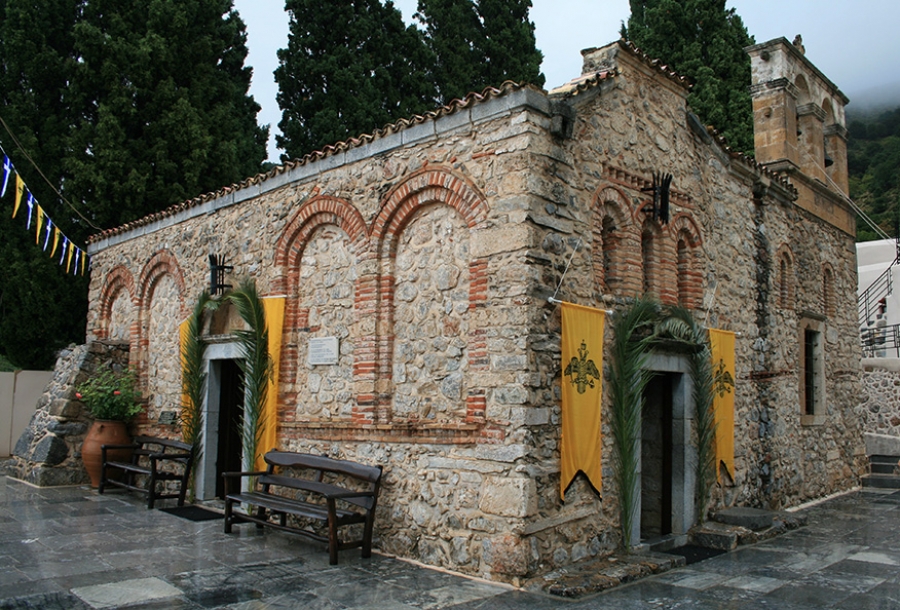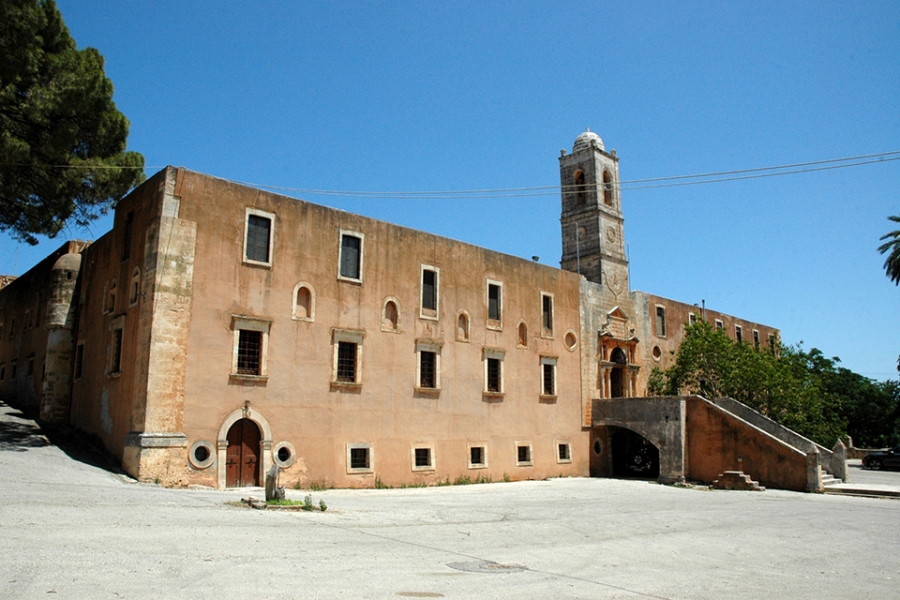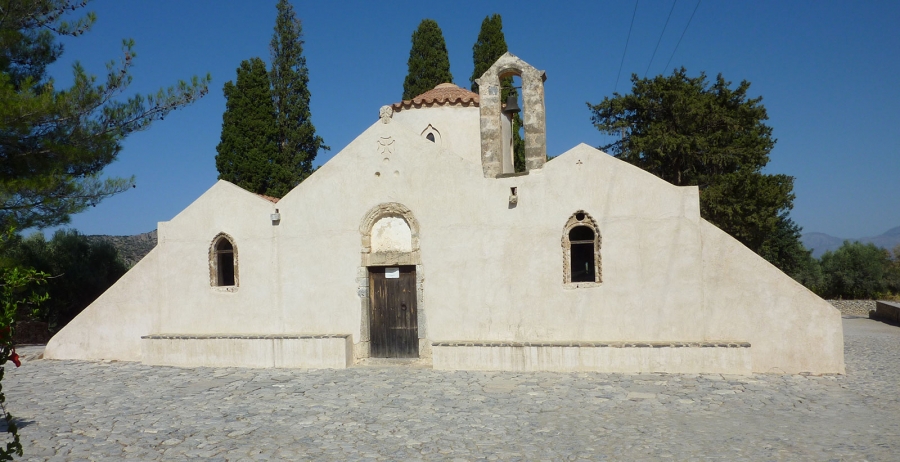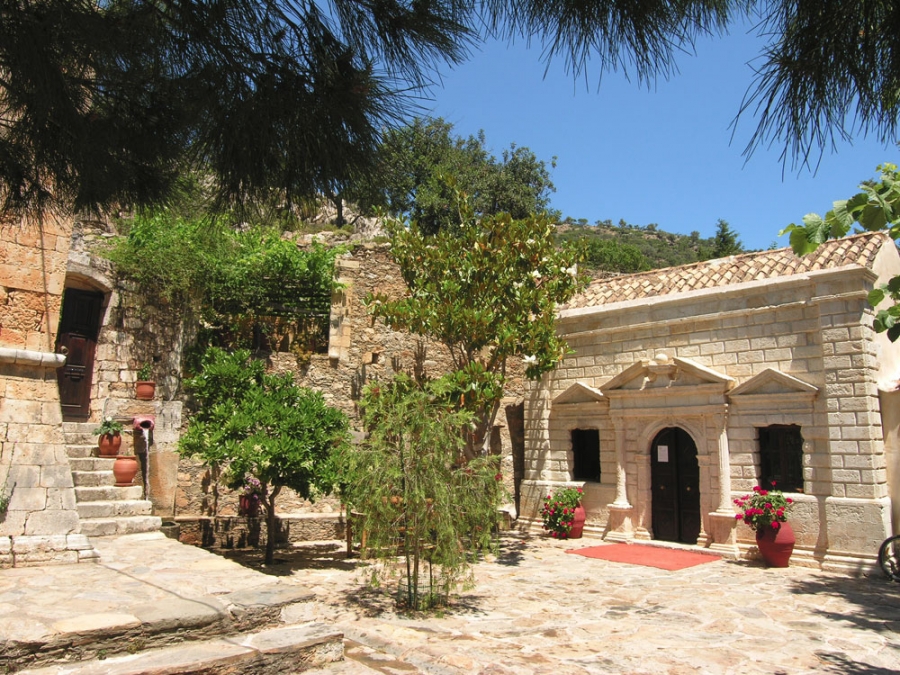Exclusive Private Services: Excursions, Shore Trips, Daily Tours & Transfers Contact Us
The Arkadi Monastery situated on the island of Crete doesn’t solely belong to this island; it belongs to Greece, Europe and to all five continents – to the whole world.
It is one of the Eastern Orthodox Monasteries underlining the catholicity and universality of the Church. Each year the Monastery receives and hosts many visitors and pilgrims from all over the world, from distant civilizations. Here are blended many languages, cultures, traditions, history and polymorphism. Nothing from the above can impede the faith unity, the catholicity of the orthodox spirit, the universality of the ecclesiastical testimony.
The Arkadi Monastery has a unique natural beauty, a prestigious history, numerous legends deeply rooted in the time, heirlooms and thesaurus richness. Possibly because the old is livelier than the new, and the modern is often more mature than the aged. Each pilgrim and visitor feels something which is exclusively his, personal, original in his experiential and spiritual experience.
A brief historical reference on the Arkadi Monastery
The Monastery has been a continuous and inseparable part of the Cretan history during the last eight centuries.
The Monastery multi-faceted deed unfolds in the passage of time. Sources show that the Monastery had been a centre of education and manuscripts copying. They also produced needlework embroidered with gold during the 17th and 18th centuries dazzling the whole world.
The Monastery battles against the conquerors inspired the whole world. The sacrifice of the people living and dying there, affected and attracted the attention of the rest of the world. The Cretan occupation by the Turks occurs during the prosperity of the Monastery.
The monks participate in the 1821 Revolt and play a leading part in the events. The first havoc is on the way. It is then that the Monastery is ransacked and abandoned by the monks for a small period of time. However, they return soon.
The highest offer of the Monastery is its self-sacrifice, heroism and pious altruism. It is the Holocaust of November 8th 1866. The Monastery gave its fights against slavery. It managed to shake off the traces that the enemy fiercely desired to settle and succeeded in changing the course of the Cretan history.
Ever since the Monastery bears the brunt of the history on its shoulders and continues taking part in the battles which followed the much afflicted island of Crete and strives in all possible ways to meet the expectations of its glory past.
The imposing church of Saint Minas was built in 1862 and symbolizes the gratitude of the people of Heraklion to the Saint for the protection offered to them during the period of the Turkish rule.
St. Minas is the patron Saint of Heraklion. The day of his celebration (November 11) is a holiday for the city. Many legends surround his name, narrating stories how he protected the city in many occasions, like when the Turks attacked and even during the German bombardments in 1941. The bomb exhibited right next to the Cathedral of St. Minas, by the staircase that leads to the plateau of St. Catherine, stands witness of the Saint’s protection as it fell at this point in 1941 but never exploded.
The famous Cretan writer Kazantzakis often refers to him in his book “Captain Michalis” (UK title “Freedom and Death”): “On midnight, when the town is in deep sleep, St. Minas descends from his icon and sets off for the quays, crossing through the neighborhoods of the Greeks; when a door he finds open, he locks it; when a christian he finds ill and sees light on his window, he stands, pleading to God to heal him”.
The Cathedral is one of the largest in Greece and was built in the mid-19th century. The construction was interrupted by the 1866 Cretan revolution and continued in 1883. The Cathedral was finally completed in 1895. To its left stands the small temple of St. Minas.
The small temple of St. Minas
The small temple of St. Minas might be smaller than the big one next to it, but it is older. It stands there since the Venetian times and after its renovation in 1735 it became the religious center of the Christians in the Turkish-occupied Chandax (Heraklion). A tragic events marked its history: in June 1821 the Turkish soldiers slaughtered everybody in the church during mass, including the priests and the bishops and the archbishop. In 1826 at Easter a second massacre was prevented when an unknown cavalryman chased the Turkish army away with his sword. According to legend, this unknown cavalryman was St.Minas, the protector of the city.
It is worth visiting the small temple of St. Minas to see the valuable icons of noteworthy Cretan icon painters of the 18th century, such as the icon of Christ's Birth (of Georgios Kydoniaios) and the icon of Panayia Galaktotrofousa (of Georgios Kastrofylakas).
The foundation and the history of the monastery, the first mention of which dates to 1333 is inextricably linked to the wonderworking icon of the All-Holy Virgin the Kardiotissa [the type of icon where the Virgin holds Christ in her arms above her heart], which according to tradition was painted by St. Lazaros, a monk and icon painter who lived during the period of Iconoclasm.
The icon was stolen during the period of Venetian occupation and transferred to the church of St. Alphonse in Rome, while the newer icon that replaced it since 1735 is considered equally mira¬culous.
Of the original monastery, only the catholicon survives today which has been structured architecturally after successive interventions to the original single-nave church. The barrel-vaulted space to the north and the three parallel to each other spaces on the west side were added subsequently. The whole was united with the addition of the large transverse narthex. The sides of the narthex are of particular interest as they are structured according to the model of ¬Byzantine architecture with blind brick arcades and ceramoplastic decoration.
The original church has mural painting decoration of the characteristic style of the painting of the first decade of the 14th century. The iconographic programme shows a peculiarity as it only has seven scenes from the Marian cycle which also happens in the cases of other monastic catholicons.
The Gospel cycle and the large representation of the Second Coming develop in the nave and the south additional aisle correspondingly, where the wall paintings are dated to the third decade of the 14th century. The wall painting and the construction of these two aisles may be connected to “the servant of God, Kali” who is depicted on the pier of the south addition in a funereal portrait. High quality wall painting decoration of the 15th century is also found in the north aisle, from which a few figures survive, such as a section of the representation of the mounted St. George.
The Monastery of Agia Triada of Tzagarolon is one of the richest and most beautiful monasteries in Crete. It is built near the airport of Chania, in the position Tzobomylos of the Cape Melecha and at the foothills of Stavros Mount.
The distance from Chania is only 15km. The monastery was built by the Venetian nobles Jeremiah and Lawrence Tzagarolo. Jeremiah was a famous scholar of his era with rich education and was a friend of the Patriarch of Alexandria, Meletios Pigas. Jeremiah himself was a candidate for Patriarch of Constantinople. Moreover, Jeremiah designed and built the monastery complex of the monastery, being affected by the architect Sebastiano Serlio from Verona, Italy.
The monastery today hosts a small museum with various pictures and icons. The most important are the 12th century cloth for covering the altar, the icons of St. John the Theologian (16th century), St. Nicholas (17th century) and the icons of the painter Skordilis: the Enthroned Christ, Living Spring and the Second Coming (1635-1645). Today, after the numerous historical adventures, the monastery continues to play an important role in the religious and economic life of Crete. It is Stavropegic, which means that it is directly managed by the Ecumenical Patriarchate of Constantinople. Visitors will see an incredibly well-preserved and vibrant monastery that produces and exports organic olive oil, wine, honey, vinegar and olive oil soap of unique quality.
The church of Panagia Kera is located southeast of the small town of Kritsa, a settlement with its own unique profile which played an important historical role. It dates from the Byzantine period, and grew considerably during the period of Venetian rule (1211-1647). One testimony to the vibrancy of Kritsa is the large number of frescoed churches in the area. By virtue of its size and rich fresco decoration, Panagia Kera is the most important of all these churches. The church’s interior was decorated with Byzantine frescos.
The church’s architecture was created by a succession of additions and interventions. The central aisle, which had the form of a domed single-naved church, comprised the original church and was probably built in the Byzantine period. Early in the period of Venetian rule the central nave was restored, the dome was rebuilt, and the side aisles were added. The presence of Venetian influences is shown by the shape of the side aisles’ windows and the dome. In the 16th century, the church acquired pediments on its eastern and western facades, recalling Renaissance prototypes. There are two layers of fresco decoration in the central nave. The first is fragmentarily preserved in the sanctuary niche and the lunettes of the arches supporting the dome.
These scenes are characterized by a linear rendering of their figures, and date to around the mid-13th century. During the first two decades of the 14th century, apparently in the wake of serious damage to the church, the second layer of frescoes was painted; these cover the remaining surfaces of the main nave and dome, with scenes from the Christological Cycle. This layer is characterized by the co-existence of elements from both Middle Byzantine and early Palaiologan art. It was the work of a local workshop that painted other churches in the region. The iconographic motifs are abundant and descriptive, painted in relatively large panels. The scenes of the Last Supper and Feast of Herod are interesting with their depictions of tables laid with food. The western wall is dominated by scenes of men and women in Hell, who form a part of the scene of the Second Coming. The figure of St. Francis on the western face of the northwest pier, rare in Cretan churches, shows the interesting absorption of a Catholic saint into Orthodox iconography. Τhe side naves were painted in the first half of the 14th century, following completion of the decoration of the central nave, and were executed according to different aesthetic principles. The south nave is devoted to St. Anne, who is depicted in the sanctuary niche. The scenes from her life are iconographically enriched by scenes from the Apocrypha and are rendered in a realistic and expressive fashion. The full-figure depictions of holy women (Eirini, Kyriaki, Varvara) that take up the lower zone of the mural decoration are impressive, as is that of St. Theodore Stratelates on the south wall. The movement and dynamism of his horse are reminiscent of ancient Greek aesthetic values. The north nave is devoted to St. Anthony and was painted with frescoes of the Second Coming. The same aesthetic principles were followed here, but the paintings were done by less capable artisans.
Dedicatory inscriptions and founders.
The dedicatory inscriptions preserved in the side naves inform us that the nave of St. Anne was rebuilt and painted with the aid of the entire village of “Kretzea” (Kritsa) and Antonios Lameras, also known as Sinouleto. The nave of St. Anthony was built with the contribution of Georgios Mazizanis and his wife. The scene with the portrait of the Mazizanis family is in the northwest corner of the nave of St. Anthony. Georgios Mazizanis is depicted with his wife and their daughter, whose face the passage of time has unfortunately erased.
Attali Monatery or Bale is located on the hills of Agia Ypakoi near Bali village and is dedicated to Saint John the Baptist.
Although the monastery dates back to the 14th century, written testimonies date back to 1628 onwards.
The Monasteries & Churches is built on numerous levels and features stables, an oil mill, baking premises, a fountain, a ceramics workshop and a Refectory featuring impressive murals.
The catholicon is not situated at the centre of the Monastery, as is common practice, but in the north-eastern side of the complex, outside the citadel built around the monastery to protect it from pirate raids. Initially, the church was a single-space structure, but was converted into a two-aisle church in the 16th century.
During the Ottoman era, the Monastery suffered extensive damage.


